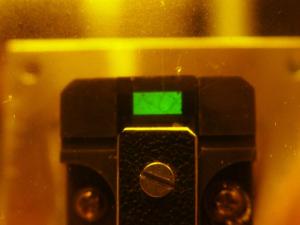 Peptronics is an Israeli company, working on Polymer OLED materials. Their idea is to use a biological-based method to make the OLEDs. In the human body, we have 20 amino acids, used as building blocks for proteins. In the same way, they have made several "OLED building blocks", which can be used to create OLED materials, using Peptronics' peptide based technology.
Peptronics is an Israeli company, working on Polymer OLED materials. Their idea is to use a biological-based method to make the OLEDs. In the human body, we have 20 amino acids, used as building blocks for proteins. In the same way, they have made several "OLED building blocks", which can be used to create OLED materials, using Peptronics' peptide based technology.
 Peptronics green OLED prototype
Peptronics green OLED prototypeThere are two types of OLEDs today: Small Molecules and Polymer based. Small Molecules are efficient and relatively easy to make, and are used in small displays today. But it is difficult to print them, and it is not easy to create a large panel using other methods. Polymer OLEDs are easily printable, and thus can be used to make large TVs - but their lifetime is short and they are less efficient.
Peptronics say that it will be possible to print cheap, large OLED TVs using their materials - which in fact will be printable (because they are polymer based), but also efficient - so it is the best of both worlds. The new materials can also be used for OLED lighting.
Peptronics are currently working on the finding the best "building-blocks" and creating numerous polymers from these building blocks using high throughput parallel synthesis. They then hope to sell their materials (or material-making systems).

